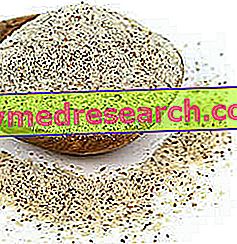Hazelnuts
Hazelnuts are the fruits of an arboreal plant belonging to the Betulaceae family, Genus Corylus, Avellana species; the binomial nomenclature of the hazelnut tree is Corylus avellana . Called hazel in the common language, it is a medium-sized tree with heart-shaped, toothed and deciduous leaves.

Its fruits, called hazelnuts, have a spherical or oval shape and vary in size (depending on the variety, but always lower than those of walnuts); externally they have a shell (woody pericarp) that protects a crunchy seed (edible part). The color of the hazelnuts is green when they are unripe and brown when ripe, when they spontaneously detach from the tree. The seed is covered by a brown fibrous film which can be (or not) removed at the time of consumption; without coating, the seed is whitish.
Hazelnut flour
Generally speaking, hazelnut flour is obtained by grinding fruits belonging to the "tonda gentile delle langhe" variety (Piedmont). The product does not include the typical nutritional characteristics of legume or cereal flour, where carbohydrates abound, but is distinguished by the prevalence of lipids on other macronutrients; for this reason, despite drying, hazelnut flour has a very limited shelf life and is often distributed under vacuum.
The use of hazelnut flour is quite varied. Ranging from the homemade packaging of desserts to the spoon, dry oven and soft oven; there is no lack of ice creams, fresh or preserved creams and spreads with nutella type cocoa.
An alternative use of hazelnut flour affects bread-making, but with a percentage limited to 10% compared to 90% of wheat flour; you get a very energetic bread rich in lipids. Recently, like all other types of alternative flour, hazelnut has been widely used in vegan diets; NOT containing gluten, it is quite used also in the CELIAC DISEASE diet.
The cost of retail hazelnut flour is high; this is due in part to the BIO regulations (for example, in the naturist diet) and partly to commercial issues. Those BIO are exclusively of Italian origin, but various European-derived products are also available. For end consumers, also online, the purchase of BIO hazelnut flour rarely falls below € 17-18 / kg.
Example of functional recipe with hazelnut flour
Laxative biscuits without butter
X Problems with video playback? Reload from YouTube Go to Video Page Go to Video Recipes Section Watch the video on youtubeSee other recipes based on hazelnuts (whole or reduced to flour)
Nutritional Properties
We reiterate that hazelnut flour does NOT contain gluten and can be used in GLUTEN-FREE diets.
The flour is extremely caloric and rich in fat; to get an idea, just think that from the hazelnuts, in addition to flour, it is possible to extract an oil. This, due to its chemical characteristics, is also used in the sophistication of extra virgin olive oil (see the article: hazelnut oil). Large quantities of hazelnut flour are therefore not recommended in case of overweight or obesity.
The intake of proteins, which are of medium biological value, is not sufficient to cover the need for plastic elements for the organism (as they lack some essential amino acids). Carbohydrates, which are predominantly simple, are more or less contained in the same quantities as proteins; they are therefore present to a much lower extent than their content in legume or cereal flours. For this reason, hazelnut flour is NOT contraindicated in case of type 2 diabetes mellitus and hypertriglyceridemia (although overweight, often associated with these diseases, imposes rational use).
Hazelnut flour helps to structure the lipid intake in the diet. Boasting a prevalence of monounsaturated fatty acids, that is omega 9 (even if omega 3 and omega 6 are not missing), it lends itself to nutrition against dyslipidemia, in particular of hypercholesterolemic; for this purpose also the richness in phytosterols contributes.
The concentration of dietary fiber is very important, essential for constipation and to moderate the risk of colon cancer; moreover, this nutritional component feeds the physiological intestinal bacterial flora and modulates the uptake of nutrients in the intestine.
Detailed information on the vitamin intake of hazelnut flour is not available, but it is possible that it is very similar to that of dried hazelnuts; obviously, in processing and storage, the losses are far from negligible. Some well-known molecules are: vitamin E, B6, folate and thiamine. For what concerns the mineral salts, instead, the concentrations of: copper, iron, manganese and calcium should stand out. Among the vitamins and mineral salts there are different nutrients with antioxidant properties, a characteristic also emphasized by certain phenolic molecules.
Finally, it should be remembered that hazelnut flour is a potentially allergenic food, therefore it should be excluded from the diet of the nurse and early childhood.
Homemade production of hazelnut flour
Hazelnut flour can also be produced at home. The operation is anything but complex and can be summarized as illustrated.
First of all, it is necessary to stock up on peeled, non-whole or whole hazelnuts; this means that, if you do not want to lose half a day shelling, boiling and peeling the seeds, it is definitely advisable to prefer semi-finished ones.
If previously boiled for peeling, the hazelnuts are then left to cool and dry. In general, it is never advisable to toast them, rather better to process them from cold or even frozen. Then, insert them in the special container of a food processor and make them blend (in a discontinuous manner so as not to heat them too much by mixing them) until reaching the floury consistency.
NB . Some add granulated sugar in proportion 1/5, but this applies only and exclusively in the case in which the hazelnut flour must be used for sweet type recipes.
Homemade hazelnut flour can be stored in a jar, as long as it is protected from light, open air and heat; however, its shelf life remains extremely limited (due to rancidity). An alternative and very effective method is freezing, even in special bags or plastic cups.
Other uses of hazelnut flour
In addition to the gastronomic application for human nutrition, hazelnut flour has also been used in ichthyoculture. To be precise, it was tested in the rainbow trout diet instead of soy flour in three different percentages: 10, 20, 30% (mixed with fish meal, etc.). The three diets did not show significant discrepancies in terms of overall growth or in the specific growth coefficient; only a small decrease in the use of food with the highest percentage (30%) was highlighted.
In the chemical-physical analysis, the muscular composition and the other trout tissues did not change in an obvious way; it would be interesting to identify more precisely the distribution of fatty acids. It is therefore logical to deduce that hazelnut flour is able to replace that of soy in the diet of rainbow trout in proportions up to 300g / kg of commercial feed.



